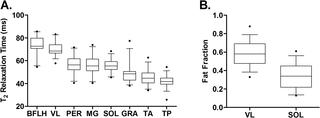PLOS ONE ( IF 3.7 ) Pub Date : 2018-03-19 , DOI: 10.1371/journal.pone.0194283 Alison M. Barnard , Rebecca J. Willcocks , Erika L. Finanger , Michael J. Daniels , William T. Triplett , William D. Rooney , Donovan J. Lott , Sean C. Forbes , Dah-Jyuu Wang , Claudia R. Senesac , Ann T. Harrington , Richard S. Finkel , Barry S. Russman , Barry J. Byrne , Gihan I. Tennekoon , Glenn A. Walter , H. Lee Sweeney , Krista Vandenborne

|
Objective
To provide evidence for quantitative magnetic resonance (qMR) biomarkers in Duchenne muscular dystrophy by investigating the relationship between qMR measures of lower extremity muscle pathology and functional endpoints in a large ambulatory cohort using a multicenter study design.
Methods
MR spectroscopy and quantitative imaging were implemented to measure intramuscular fat fraction and the transverse magnetization relaxation time constant (T2) in lower extremity muscles of 136 participants with Duchenne muscular dystrophy. Measures were collected at 554 visits over 48 months at one of three imaging sites. Fat fraction was measured in the soleus and vastus lateralis using MR spectroscopy, while T2 was assessed using MRI in eight lower extremity muscles. Ambulatory function was measured using the 10m walk/run, climb four stairs, supine to stand, and six minute walk tests.
Results
Significant correlations were found between all qMR and functional measures. Vastus lateralis qMR measures correlated most strongly to functional endpoints (|ρ| = 0.68–0.78), although measures in other rapidly progressing muscles including the biceps femoris (|ρ| = 0.63–0.73) and peroneals (|ρ| = 0.59–0.72) also showed strong correlations. Quantitative MR biomarkers were excellent indicators of loss of functional ability and correlated with qualitative measures of function. A VL FF of 0.40 was an approximate lower threshold of muscle pathology associated with loss of ambulation.
Discussion
Lower extremity qMR biomarkers have a robust relationship to clinically meaningful measures of ambulatory function in Duchenne muscular dystrophy. These results provide strong supporting evidence for qMR biomarkers and set the stage for their potential use as surrogate outcomes in clinical trials.
中文翻译:

骨骼肌磁共振生物标记物与杜氏肌营养不良症的功能和前哨事件相关
客观的
使用多中心研究设计,通过调查大型非卧床队列中下肢肌肉病理学的qMR量度与功能终点之间的关系,为杜氏肌营养不良症中的定量磁共振(qMR)生物标记物提供证据。
方法
MR光谱法和定量成像技术用于测量136名患有Duchenne肌营养不良症的参与者的下肢肌肉的肌内脂肪含量和横向磁化弛豫时间常数(T 2)。在三个成像站点之一中,在48个月内的554次访问中收集了测量值。使用MR光谱法测量比目鱼肌和外侧比肌的脂肪含量,而使用MRI对8个下肢肌肉的T 2进行评估。使用10m步行/跑步,爬四个楼梯,仰卧站立和六分钟步行测试来测量门诊功能。
结果
在所有qMR和功能指标之间发现了显着的相关性。尽管在包括股二头肌(|ρ| = 0.63–0.73)和腓骨(|ρ| = 0.59–0.72)的其他快速发展的肌肉中进行测量,但外侧外翻qMR量度与功能终点的相关性最强(|ρ| = 0.68-0.78) )也显示出很强的相关性。MR定量生物标记物是功能丧失能力的极好指标,并且与功能的定性指标相关。VL FF为0.40,这是与运动功能下降相关的肌肉病理学较低的阈值。
讨论
下肢qMR生物标记物与杜氏肌营养不良症的门诊功能的临床有意义的措施有着密切的关系。这些结果为qMR生物标志物提供了有力的支持证据,并为它们在临床试验中作为替代结果的潜在应用奠定了基础。


























 京公网安备 11010802027423号
京公网安备 11010802027423号